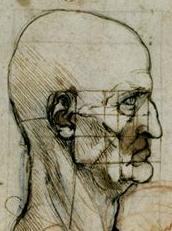Leonardo: the math of art
By Murray Bourne, 09 Mar 2007
Universal Leonardo is an interesting site that explores da Vinci’s paintings, drawings and inventions.
The "mathematics trail" is especially interesting. The short descriptions outlining the background and implications of each drawing or painting are easily accessible. Also, there are "In Depth" sections that explain concepts more fully. I liked the one on Divine Proportion.
This idea of an ideal human proportion followed not only from the medieval view that "God was seen as a sort of divine ’geometer” who created everything on the basis of number and proportion", but also:
Leonardo wanted to create an ideal of human proportions. The idea came from Plato and Vitruvius, who pointed out that the proportions of the human body were analogous to the parts of an ideal temple.
This works as follows:
4 fingers make 1 palm, and 4 palms make 1 foot, 6 palms makes 1 cubit; 4 cubits makes 1 pace and 24 palms makes a man; and these measures he uses in his buildings.
[However, these are pretty strange proportions - try it on your own body. My foot is certainly not 4 palms long. A "cubit" is the length from your elbow to the tip of your longest finger (or not).]
Check out Universal Leonardo - it’s a good summary of the contributions of a brilliant man.
Footnote 1: Of course (considering the name of this blog), I also enjoyed the section on Squaring the Circle.
Footnote 2: You may also be interested in Math of Beauty on the Interactive Mathematics site.
See the 1 Comment below.

22 Oct 2009 at 1:08 am [Comment permalink]
in the text above, the part where it says: '4 fingers make 1 palm, and 4 palms make 1 foot, 6 palms makes 1 cubit; .. '
i think the 1 foot is the measurement of 1 foot..
not the size of your foot